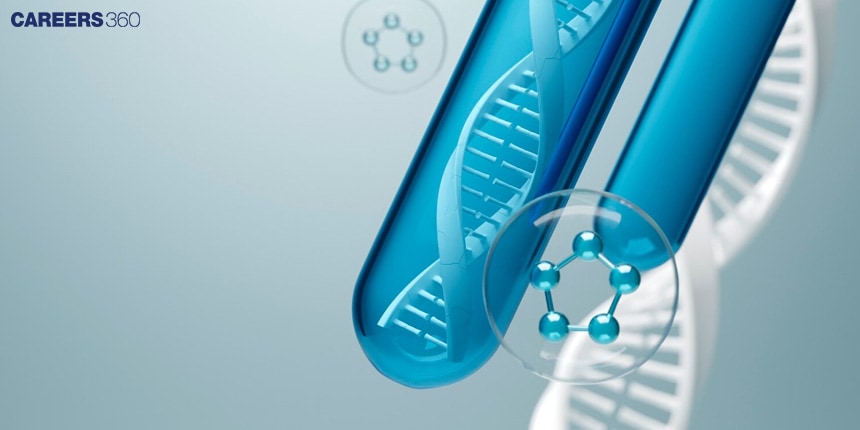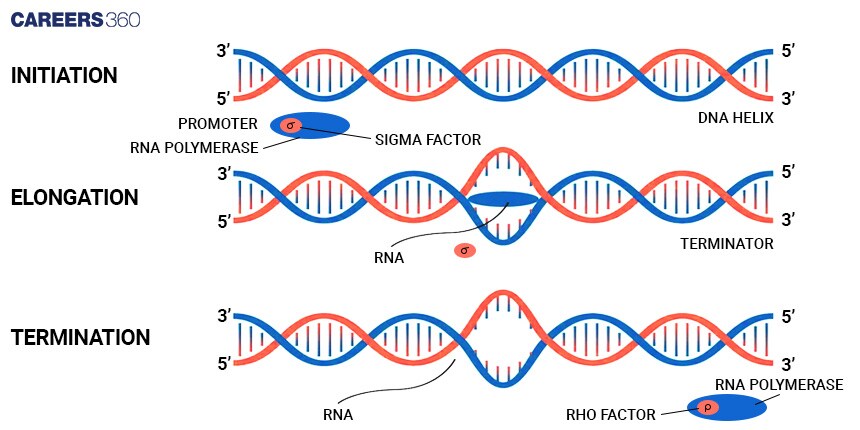Process of Transcription: Know Stages, RNA Polymerase
Transcription Definition: Transcription is the process where the information in DNA is copied into a molecule called messenger RNA (mRNA). This is the first step in making proteins, which are very important for the body. Transcription makes sure that the instructions in DNA are used by the cell. This topic is from the Class 12 chapter Molecular Basis of Inheritance in Biology. This article contains information about how transcription occurs, which type of RNA is involved, what enzymes like RNA polymerase do, and why steps of transcription are important in making proteins.
NEET 2025: Mock Test Series | Syllabus | High Scoring Topics | PYQs
NEET Important PYQ's Subject wise: Physics | Chemistry | Biology
New: Meet Careers360 B.Tech/NEET Experts in your City | Book your Seat now
- What is Transcription?
- Where does Transcription take Place?
- Central Dogma of Molecular Biology
- Stages of Transcription
- Post-Transcriptional Modifications in Eukaryotes
- Mechanisms of Transcription Regulation
- Applications and Importance of Transcription

What is Transcription?
Transcription is a process by which DNA gets copied into RNA. This process is important in the course of gene expression because it leads to the production of mRNA, which in turn is utilized for making proteins. While making RNA during transcription, it takes the template from DNA. It is a part of the central dogma in molecular biology.
Where does Transcription take Place?
Transcription occurs in different cellular locations depending on whether the organism is a prokaryote or a eukaryote. In eukaryotic cells, it occurs inside the nucleus. In prokaryotic cells, it occurs in the cytoplasm.
Also Read:
- Practice MCQ on the Process of Transcription
- Molecular Basis of Inheritance
- Genetic Material
- Principles of Inheritance and Variation
Central Dogma of Molecular Biology
The central dogma explains the flow of genetic information within a biological system.
DNA is transcribed into RNA, which is then translated into protein.
This process underlies the flow of genetic information in cells.
Role of Transcription in Central Dogma
Transcription is one of the initial steps in the central dogma, where it joins DNA to the production of RNA.
Transcription is the process by which the information contained in the DNA triple code is duplicated into a complementary RNA series.
It facilitates the synthesis of proteins by the cell based on its genetic information.
Key Components Involved in Transcription
The primary components involved are:
DNA Template
A strand of the DNA template is used by RNA polymerase to synthesise RNA.
The antisense strand of DNA acts as a template for RNA synthesis.
The sense strand is identical to the RNA transcript produced (except that thymine is replaced with uracil).
RNA Polymerase
RNA polymerase is the enzyme that catalyses transcription.
RNA polymerase binds to the DNA and synthesises RNA by adding nucleotides.
Prokaryotes have only one type of RNA polymerase, eukaryotes have three types: I, II, and III.
Promoters and Transcription Factors
Promoters are DNA sequences that mark the beginning of transcription, and transcription factors are proteins that bind to specific DNA sequences, facilitating the binding of RNA polymerase to DNA.
Promoters lie upstream of the gene and thus play a crucial role in the initiation of transcription.
Transcription factors modulate this binding of RNA polymerase to the promoter, hence regulating gene expression.
Stages of Transcription
The following steps are seen in the mechanism of Transcription:
Step 1: Initiation
The process of initiation is the beginning of RNA synthesis.
RNA polymerase binds to the promoter region of the DNA.
The transcription initiation complex is formed, and the process of DNA unwinding begins.
Step 2: Elongation
In elongation, RNA polymerase travels along the DNA synthesising RNA.
RNA polymerase adds nucleotides to the growing mRNA strand in a 5' to 3' direction.
The DNA unwinds ahead of RNA polymerase and rewinds behind it.
Step 3: Termination
Termination signals the end of transcription and the release of the RNA molecule.
It is these specific terminator sequences in the DNA that cause the RNA polymerase to stop and release the mRNA transcript.
In eukaryotes, termination is followed by other processing steps.
Diagram: Transcription Process in prokaryotes

Post-Transcriptional Modifications in Eukaryotes
The post-transcriptional modifications are:
5' Capping
The 5' cap is attached to the 5' end of the mRNA molecule. It protects the mRNA from degradation.
A modified guanine nucleotide is added to the 5' end of the mRNA.
This cap is essential for mRNA stability and recognition by the ribosome.
Polyadenylation
This process adds a tail composed of adenine nucleotides to the 3' end of the mRNA.
The poly-A tail protects mRNA from enzymatic degradation.
It also facilitates the export of mRNA from the nucleus to the cytoplasm.
Splicing
This is a step where the non-coding regions are removed from the pre-mRNA and the coding regions are joined together. The spliceosome complex cuts out introns and joins exons together.
This process is essential for producing a functional mRNA transcript.
Alternative Splicing
Alternative splicing allows a single gene to yield multiple variants of mRNA. This allows for increasing protein diversity.
The joining of different sets of exons leads to the formation of different types of mRNAs.
Different types of proteins originate from a single gene.
Mechanisms of Transcription Regulation
The following are the mechanisms of the process of transcription:
Transcription Factors and Enhancers
Transcription factors and enhancers are the most prominent players involved in gene expression.
The modulation of the rate of transcription comes about by the binding of transcription factors to definite sequences of DNA.
Enhancers raise the effectiveness of the transcriptional procedure through their interaction with the promoter region.
Epigenetic Regulation
Epigenetic alterations may also affect transcription without any alteration in the DNA sequence.
DNA methylation and histone alterations result in repression or activation of transcription.
Such modifications are heritable and play a role in gene regulation.
Feedback Loops
Cells adopt the system of feedback loops in regulating transcription as well as in the maintenance of homeostasis.
Positive feedback is when the product produced through gene expression stimulates its transcription, increasing it.
The negative feedback, on the other hand, is a turned-off expression of genes due to their products.
Examples include the regulation of hormone production and metabolic pathways.
Applications and Importance of Transcription
Understanding this process of transcription helps in:
Studies of Gene Expression
In studying gene function and expression, one needs to understand transcription.
Transcription analysis studies how genes are regulated.
Such knowledge can help comprehend the nature of diseases and developmental processes.
Medical Implications
It is an area of medical research because diseases can occur from transcription errors.
Misregulation of transcription leads to cancer, genetic disorders, and other diseases.
Targeting transcription factors has become a strategy for developing new therapies.
Applications in Biotechnology
Transcription plays a huge role in genetic engineering or synthetic biology.
Scientists manipulate transcription to produce recombinant proteins and genetically modified organisms.
It is used in developing gene therapies and studying gene function.
Also Read:
| Human Genome Project | Chromosomes |
| Process of Translation | Difference between DNA and RNA |
| Chargaff's Rule | Types of DNA |
Recommended Video for The Process of Transcription
Frequently Asked Questions (FAQs)
RNA polymerase synthesises RNA by the addition of nucleotides complementary to the DNA template. It plays a necessary role in allowing the process of transcription to initiate and be driven.
Prokaryotic transcription is less complex, occurs in the cytoplasm, and lacks extensive post-transcriptional modifications. Eukaryotic ones are more complex, nuclear and have several steps of regulation.
RNA polymerase binds to the DNA in initiation, synthesises RNA in elongation, and is released with the RNA transcript in termination.
The post-transcriptional modifications, which include capping, polyadenylation, and splicing, are all crucial to mRNA stability, export, and translation efficiency in eukaryotes.
Transcription is controlled by the transcription factors and enhancers, associated with epigenetic modifications, responsible for turning genes on or off depending upon cellular needs.
Also Read
29 Nov'24 09:31 AM
19 Nov'24 09:26 AM
18 Nov'24 06:45 PM
18 Nov'24 09:29 AM
18 Nov'24 09:18 AM
18 Nov'24 09:01 AM
18 Nov'24 08:37 AM
16 Nov'24 03:45 PM
